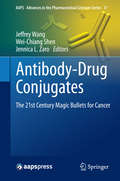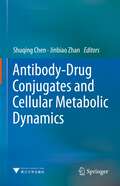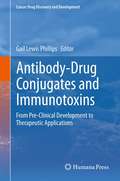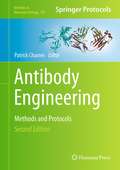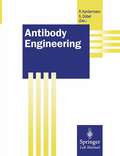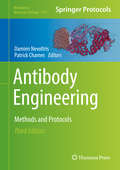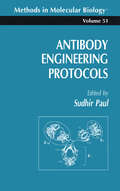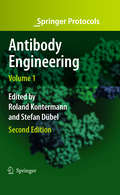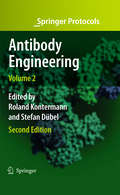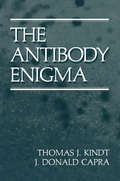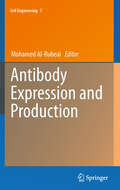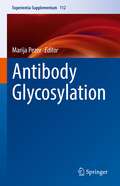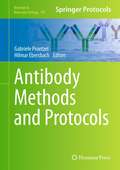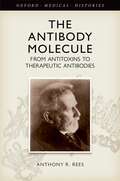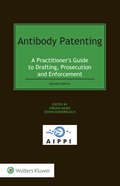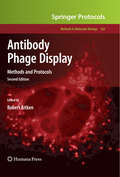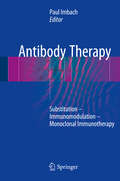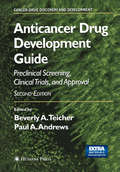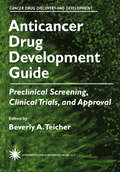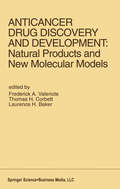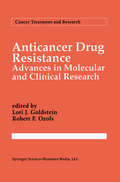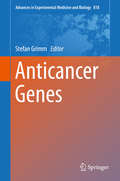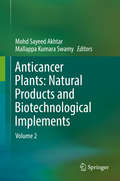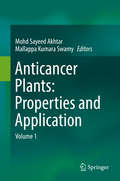- Table View
- List View
Antibody-Drug Conjugates: The 21st Century Magic Bullets for Cancer (AAPS Advances in the Pharmaceutical Sciences Series #17)
by Jeffrey Wang Wei-Chiang Shen Jennica L. ZaroThis authoritative volume provides a holistic picture of antibody-drug conjugates (ADCs). Fourteen comprehensive chapters are divided into six sections including an introduction to ADCs, the ADC construct, development issues, landscape, IP and pharmacoeconomics, case studies, and the future of the field. The book examines everything from the selection of the antibody, the drug, and the linker to a discussion of developmental issues such as formulations, bio-analysis, pharmacokinetic-pharmacodynamic relationships, and toxicological and regulatory challenges. It also explores pharmacoecomonics and intellectual properties, including recently issued patents and the cost analysis of drug therapy. Case studies are presented for the three ADCs that have received FDA approval: gemtuzumab ozogamicin (Mylotarg®), Brentuximab vedotin (Adcetris®), and ado-trastuzumab emtansine (Kadcyla®), as well as an ADC in late-stage clinical trials, glembatumumab vedotin (CDX-011). Finally, the volume presents a perspective by the editors on the future directions of ADC development and clinical applications. Antibody-Drug Conjugates is a practical and systematic resource for scientists, professors, and students interested in expanding their knowledge of cutting-edge research in this exciting field.
Antibody-Drug Conjugates and Cellular Metabolic Dynamics
by Shuqing Chen Jinbiao ZhanThis book summarizes the related research achievements in Antibody-drug conjugates (ADCs) and their cell metabolism kinetics. The book has three main parts. The first part describes the basic theory of ADCs, including the basic concept and structure of ADCs, and the relationship between the targets of ADCs and their specific functions. The second part mainly introduces the endocytosis and intracellular metabolism of ADCs, including the relationship between endocytosis and ADC activity, the endocytosis and intracellular transport of ADCs, the distribution and metabolism of ADC in vivo. Then it discusses the new formats and research technology of ADCs, including the application of miniaturized antibodies in ADC synthesis, novel carriers for ADC design, the technology and application of site-specific conjugation, and approaches for analyzing the drug: antibody ratio (DAR), the study of pharmacokinetics of ADCs. This book combines the basic theory with the research technology. It can be used as a reference book for students, teachers and researchers of biomedical field.
Antibody-Drug Conjugates and Immunotoxins: From Pre-Clinical Development to Therapeutic Applications (Cancer Drug Discovery and Development)
by Gail Lewis PhillipsThis volume gathers the leading research on antibody-drug conjugates and immunotoxins. Following a rigorous overview, the volume delves into focused sections on all aspects of ADCs and ITs from clinical development through to targeted therapeutic applications and the latest technologies.
Antibody Engineering: Methods and Protocols, Second Edition (Methods in Molecular Biology #907)
by Patrick ChamesMore than ever, antibodies are being recognized as a major drug modality in a variety of diseases, including cancer, autoimmune diseases, infectious diseases, or even neurodegenerative disorders. Over 30 therapeutic antibodies have been approved and novel molecules are entering clinical trials at an average rate of 50 per year and that is predicted to continue well into the future. Notwithstanding the many achievements already made in the field, there is still a lot of room for improvements for these molecules in terms of activity, and a plethora of approaches have been attempted to optimize these molecules. Antibody Engineering: Methods and Protocols, Second Edition was compiled to give complete and easy access to a variety of antibody engineering techniques, starting from the creation of antibody repertoires and efficient ways to select binders from these repertoires, to their production in various hosts, their detailed characterization using various well established techniques, and to the modification and optimization of these lead molecules in terms of binding activity, specificity, size, shape, and more. Written in the successful Methods in Molecular Biology™ series format, chapters include introductions to their respective topics, lists of the necessary materials and reagents, step-by-step, readily reproducible protocols, and notes on troubleshooting and avoiding known pitfalls. Authoritative and easily accessible, Antibody Engineering: Methods and Protocols, Second Edition serves as an invaluable resource for both experts and those new to the field, and most of all as a source of inspiration for the creation of the antibodies of tomorrow.
Antibody Engineering (Springer Lab Manuals)
by Roland E. Kontermann Stefan DübelInterest in recombinant antibody technologies has rapidly increased because of its wide range of possible applications in therapy, diagnosis, and especially, cancer treatment. The possibility of generating human antibodies that are not accessible by conventional polyclonal or monoclonal approaches has facilitated the development of antibody engineering technologies. This manual presents a comprehensive collection of detailed step-by-step protocols, provided by experts. The text covers all basic methods needed in antibody engineering as well as recently developed and emerging technologies.
Antibody Engineering: Methods and Protocols (Methods in Molecular Biology #1827)
by Damien Nevoltris Patrick ChamesThis detailed new edition provides complete and easy access to a variety of antibody engineering techniques. The volume explores topics such as the generation of native, synthetic, or immune antibody libraries, the selection of lead candidates via the different powerful and innovative display technologies, Fc engineering, as well as their production, characterization, and optimization of antibodies. Written for the highly successful Methods in Molecular Biology series, chapters include introductions to their respective topics, lists of the necessary materials and reagents, step-by-step, readily reproducible laboratory protocols, and tips on troubleshooting and avoiding known pitfalls. Authoritative and up-to-date, Antibody Engineering: Methods and Protocols, Third Edition presents the reader with an extensive toolbox to create the powerful molecules of tomorrow.
Antibody Engineering Volume 1 (Springer Laboratory Manual Ser.)
by Roland Kontermann Stefan DübelAntibodies are indispensable tools for research, diagnosis, and therapy. Recombinant approaches allow the modification and improvement of nearly all antibody properties, such as affinity, valency, specificity, stability, serum half-life, effector functions, and immunogenicity. "Antibody Engineering" provides a comprehensive toolbox covering the well-established basics but also many exciting new techniques. The protocols reflect the latest "hands on" knowledge of key laboratories in this still fast-moving field. Newcomers will benefit from the proven step-by-step protocols, which include helpful practical advice; experienced antibody engineers will appreciate the new ideas and approaches. The book is an invaluable resource for all those engaged in antibody research and development.
Antibody Engineering Volume 2 (Springer Laboratory Manual Ser.)
by Roland Kontermann Stefan DübelAntibodies are indispensable tools for research, diagnosis, and therapy. Recombinant approaches allow the modification and improvement of nearly all antibody properties, such as affinity, valency, specificity, stability, serum half-life, effector functions, and immunogenicity. "Antibody Engineering" provides a comprehensive toolbox covering the well-established basics but also many exciting new techniques. The protocols reflect the latest "hands on" knowledge of key laboratories in this still fast-moving field. Newcomers will benefit from the proven step-by-step protocols, which include helpful practical advice; experienced antibody engineers will appreciate the new ideas and approaches. The book is an invaluable resource for all those engaged in antibody research and development.
The Antibody Enigma
by Thomas KindtThe Antibody Enigma is a somewhat personal view of the antibody diversity question from two investigators who have spent the past 18 years trying to penetrate the enigma. It is not and was not meant to be an all-embracing comprehensively referenced review of the subject of antibody diversity. Because of the subjective viewpoint, there are un doubtedly omissions of data that others consider to be seminal, and if we have offended anyone by omitting their own contribution we sin cerelyapologize. We have lived with "The Enigma" on and off for the past two years. It has been both hard work and good fun but, above all, it has been a learning experience. There were several difficult decisions to make in putting together the final text, but perhaps the most difficult was de ciding upon a stopping point. The field of antibody diversity is presently enjoying an unparalleled expansion of information, and because of this it was very tempting to await further developments in hopes of tying up as many loose ends as possible. This was decided against for several reasons; the major factor was that the project was growing burdensome for both of us. From a more objective point of view this appears to be a reasonable time to stop our exposition.
Antibody Expression and Production (Cell Engineering #7)
by Mohamed Al-RubeaiEngineered antibodies currently represent over 30% of biopharmaceuticals in clinical trials and their total worldwide sales continue to increase significantly. The importance of antibody applications is reflected in their increasing clinical and industrial applications as well as in the progression of established and emerging production strategies. This volume provides detailed coverage of the generation, optimization, characterization, production and applications of antibody. It provides the necessary theoretical background and description of methods for the expression of antibody in microbial and animal cell cultures and in transgenic animals and plants. There is a strong focus on those issues related to the production of intrabodies, bispecific antibody and antibody fragments and also to novel applications in cancer immunotherapy.
Antibody Glycosylation (Experientia Supplementum #112)
by Marija PezerThis book summarizes recent advances in antibody glycosylation research. Covering major topics relevant for immunoglobulin glycosylation - analytical methods, biosynthesis and regulation, modulation of effector functions - it provides new perspectives for research and development in the field of therapeutic antibodies, biomarkers, vaccinations, and immunotherapy.Glycans attached to both variable and constant regions of antibodies are known to affect the antibody conformation, stability, and effector functions. Although it focuses on immunoglobulin G (IgG), the most explored antibody in this context, and unravels the natural phenomena resulting from the mixture of IgG glycovariants present in the human body, the book also discusses other classes of human immunoglobulins, as well as immunoglobulins produced in other species and production systems. Further, it reviews the glycoanalytical methods applied to antibodies and addresses a range of less commonly explored topics, such as automatization and bioinformatics aspects of high-throughput antibody glycosylation analysis. Lastly, the book highlights application areas ranging from the ones already benefitting from antibody glycoengineering (such as monoclonal antibody production), to those still in the research stages (such as exploration of antibody glycosylation as a clinical or biological age biomarker), and the potential use of antibody glycosylation in the optimization of vaccine production and immunization protocols. Summarizing the current knowledge on the broad topic of antibody glycosylation and its therapeutic and biomarker potential, this book will appeal to a wide biomedical readership in academia and industry alike.Chapter 4 is available open access under a Creative Commons Attribution 4.0 International License via link.springer.com.
Antibody Methods and Protocols (Methods in Molecular Biology #901)
by Gabriele Proetzel and Hilmar EbersbachThe rapidly growing field of antibody research is the result of many advancing technologies allowing current developments to take advantage of molecular engineering to create tailor-made antibodies. Antibody Methods and Protocols attempts to provide insight into the generation of antibodies using in vitro and in vivo approaches, as well as technical aspects for screening, analysis, and modification of antibodies and antibody fragments. The detailed volume is focused on basic protocols for isolating antibodies and, at the same time, it selects a range of specific areas with the aim of providing guides for the overall process of antibody isolation and characterization as well as protocols for enhancing classical antibodies and antibody fragments. Written in the highly successful Methods in Molecular Biology™ series format, chapters include introductions to their respective topics, lists of the necessary materials and reagents, step-by-step, readily reproducible laboratory protocols, and tips on troubleshooting and avoiding known pitfalls. Authoritative and easy to use, Antibody Methods and Protocols provides a broad and useful background to support ongoing efforts by novices and experts alike and encourages the development of new imaginative approaches to this vital area of study.
The Antibody Molecule: From antitoxins to therapeutic antibodies (Oxford Medical Histories)
by Anthony R. ReesThe Antibody Molecule follows the extraordinary journey of the medics and scientists who shaped the course of medical advances in the field of immunology. One of the oldest of the medical sciences, immunology has a history that has seen chemists, physicists and biologists alike seeking to unravel the most complex system in the human body outside the brain. This book charts its intriguing history, from the genetic basis of antibody diversity, through the understanding of the mechanism by which the immune system's first line of defence works, to breakthroughs in crystallography and the exploitation of immunoglobulins as therapeutic platforms to treat cancer, inflammation and allergy. Tracing the developments in immunology in chronological order, Professor Anthony R. Rees presents the historical contexts of the periods in rich detail, bringing them to life with quotes and illustrations. This fascinating book examines the literature of the time, turning points, and controversies. A must read for immunologists and life scientists, as well as historians of science and medicine.
The Antibody Molecule: From antitoxins to therapeutic antibodies (Oxford Medical Histories)
by Anthony R. ReesThe Antibody Molecule follows the extraordinary journey of the medics and scientists who shaped the course of medical advances in the field of immunology. One of the oldest of the medical sciences, immunology has a history that has seen chemists, physicists and biologists alike seeking to unravel the most complex system in the human body outside the brain. This book charts its intriguing history, from the genetic basis of antibody diversity, through the understanding of the mechanism by which the immune system's first line of defence works, to breakthroughs in crystallography and the exploitation of immunoglobulins as therapeutic platforms to treat cancer, inflammation and allergy. Tracing the developments in immunology in chronological order, Professor Anthony R. Rees presents the historical contexts of the periods in rich detail, bringing them to life with quotes and illustrations. This fascinating book examines the literature of the time, turning points, and controversies. A must read for immunologists and life scientists, as well as historians of science and medicine.
Antibody Patenting: A Practitioner's Guide to Drafting, Prosecution and Enforcement (AIPPI Series #5)
by Jürgen Meier Oswin Ridderbusch<p style="text-align:justify;mso-layout-grid-align:none; text-autospace:none" class="MsoNormal">Antibodies have revolutionized medicine and biotechnology, and have become indispensable tools in therapy, diagnostics, analytics, and research. Therapeutic antibodies, for example, have become firmly established in the ranks of blockbuster drugs, currently accounting for about half of the top 10 best-selling medicines. At the same time, a body of case law dealing specifically with the patentability of antibody-related inventions and the enforcement of antibody patents has emerged in major jurisdictions. The, at times, significant divergences between different jurisdictions have been compounded by recent decisions in the United States, which have severely curtailed the possibilities to obtain broad antibody patents. It is therefore essential to understand how antibody inventions are assessed in different jurisdictions in order to secure an optimal patent protection and to successfully enforce such patents. <p style="text-align:justify;mso-layout-grid-align:none; text-autospace:none" class="MsoNormal">This book provides practitioners with a comprehensive resource elucidating all aspects of the patenting of antibodies from initial drafting and prosecution to enforcement, using a country-by-country format. The updated and expanded Second Edition covers more than 30 of the most important IP jurisdictions worldwide – i.e., the European Patent Office, Belgium, Denmark, Finland, France, Germany, Hungary, Ireland, Italy, the Netherlands, Poland, Spain, Sweden, Switzerland, the United Kingdom, the United States of America, Canada, Mexico, the Andean Community (Bolivia, Colombia, Ecuador, and Peru), Argentina, Brazil, Chile, China, India, Israel, Japan, Singapore, South Korea, Taiwan, Australia, and New Zealand. The 49 contributors to this book, all distinguished experts in this field, provide clear and practice-oriented advice on a range of topics including: <p style="text-align:justify;mso-layout-grid-align:none; text-autospace:none" class="MsoNormal"> • Which types of antibody inventions are patent-eligible? <p style="margin-left:14.2pt;mso-add-space: auto;text-align:justify;text-indent:-14.2pt;mso-list:l0 level1 lfo1;mso-layout-grid-align: none;text-autospace:none" class="MsoListParagraphCxSpMiddle">• Which types of functional and structural features are accepted for claiming antibodies? <p style="margin-left:14.2pt;mso-add-space: auto;text-align:justify;text-indent:-14.2pt;mso-list:l0 level1 lfo1;mso-layout-grid-align: none;text-autospace:none" class="MsoListParagraphCxSpMiddle">• What needs to be considered when defining antibodies in terms of their antigen, target affinity, binding specificity, epitope, competitive binding and other characteristics in relation to reference antibodies, as well as their effects on the target? <p style="margin-left:14.2pt;mso-add-space: auto;text-align:justify;text-indent:-14.2pt;mso-list:l0 level1 lfo1;mso-layout-grid-align: none;text-autospace:none" class="MsoListParagraphCxSpMiddle">• Which pitfalls must be avoided when defining amino acid sequences, chemical modifications or glycosylation patterns, and when relying on cell line deposits? <p style="margin-left:14.2pt;mso-add-space: auto;text-align:justify;text-indent:-14.2pt;mso-list:l0 level1 lfo1;mso-layout-grid-align: none;text-autospace:none" class="MsoListParagraphCxSpMiddle">• Which breadth of claims is accepted for antibody inventions, and what experimental support is required? <p style="margin-left:14.2pt;mso-add-space: auto;text-align:justify;text-indent:-14.2pt;mso-list:l0 level1 lfo1;mso-layout-grid-align: none;text-autospace:none" class="MsoListParagraphCxSpMiddle">• Which specific medical applications of antibodies can be claimed? <p style="margin-left:14.2pt;mso-add-space: auto;text-align:justify;text-indent:-14.2pt;mso-list:l0 level1 lfo1;mso-layout-grid-align: none;text-autospace:none" class="MsoListParagraphCxSpMiddle">• How is inventive step assessed in the specific case of anti
Antibody Phage Display: Methods and Protocols (Methods in Molecular Biology #562)
by Robert AitkenSince its introduction almost 20 years ago, phage display technology has revolutionized approaches to the analysis of biomedical problems, quickly impacting the fields of immunology, cell biology, biotechnology, pharmacology, and drug discovery. In Antibody Phage Display: Methods and Protocols, Second Edition, expert researchers explore the latest in this cutting-edge technology, providing an invaluable resource that will guide readers in the design and execution of experiments based around antibody phage display. Chapters present a wide range of methods of isolating recombinant antibodies from phage display libraries, examine how the targets recognized by antibodies of interest can be identified, discuss the identification and exploitation of antibodies that can enter cells and bind to cytosolic targets, and include novel approaches to the expression of recombinant antibodies. Composed in the highly successful Methods in Molecular Biology™ series format, each chapter contains a brief introduction, step-by-step methods, a list of necessary materials, and a Notes section which shares tips on troubleshooting and avoiding known pitfalls. Detailed and innovative, Antibody Phage Display: Methods and Protocols, Second Edition is a critical handbook on phage display technology which is certain to stimulate the reader’s imagination as much as it will guide future practice in the laboratory.
Antibody Therapy: Substitution – Immunomodulation – Monoclonal Immunotherapy
by Paul ImbachThis practical manual, written by well-known experts, reviews current indications for the use of IgG concentrates and some other modern immunomodulators and provides fundamental information on present-day immunomodulation in patients (and mice). The book opens by tracing the transition from IgG substitution to IgG immunomodulation and providing expert updates on immunomodulatory indications in autoimmune and inflammatory disorders, including hematologic, neurologic, dermatologic, and other diseases. Basic aspects of IgG concentrates, including methods of production, safety, currently available products, and mechanisms of action, are then discussed. An entire chapter is devoted to the different aspects of immunomodulatory IgG treatment in the bleeding disorder immune thrombocytopenia (ITP). Finally, the transition from polyclonal to monoclonal antibody (mAb) treatment is addressed in detail, covering mAb development, methods, mechanisms of action, adverse effects, and more. Particular attention is paid to the example of anti-CD20 (B-cell) antibody.
Anticancer Drug Development Guide: Preclinical Screening, Clinical Trials, and Approval (Cancer Drug Discovery and Development #Vol. 2)
by Paul A. Andrews Beverly A. TeicherThis unique volume traces the critically important pathway by which a "molecule" becomes an "anticancer agent. " The recognition following World War I that the administration of toxic chemicals such as nitrogen mustards in a controlled manner could shrink malignant tumor masses for relatively substantial periods of time gave great impetus to the search for molecules that would be lethal to specific cancer cells. Weare still actively engaged in that search today. The question is how to discover these "anticancer" molecules. Anticancer Drug Development Guide: Preclinical Screening, Clinical Trials, and Approval, Second Edition describes the evolution to the present of preclinical screening methods. The National Cancer Institute's high-throughput, in vitro disease-specific screen with 60 or more human tumor cell lines is used to search for molecules with novel mechanisms of action or activity against specific phenotypes. The Human Tumor Colony-Forming Assay (HTCA) uses fresh tumor biopsies as sources of cells that more nearly resemble the human disease. There is no doubt that the greatest successes of traditional chemotherapy have been in the leukemias and lymphomas. Since the earliest widely used in vivo drug screening models were the murine L 1210 and P388 leukemias, the community came to assume that these murine tumor models were appropriate to the discovery of "antileukemia" agents, but that other tumor models would be needed to discover drugs active against solid tumors.
Anticancer Drug Development Guide: Preclinical Screening, Clinical Trials, and Approval (Cancer Drug Discovery and Development)
by Beverly A. TeicherExperienced cancer researchers from pharmaceutical companies, government laboratories, and academia comprehensively review and describe the arduous process of cancer drug discovery and approval. They focus on using preclinical in vivo and in vitro methods to identify molecules of interest, detailing the targets and criteria for success in each type of testing and defining the value of the information obtained from the various tests. They also define each stage of clinical testing, explain the criteria for success, and outline the requirements for FDA approval. A companion volume by the same editor (Cancer Therapeutics: Experimental and Clinical Agents) reviews existing anticancer drugs and potential anticancer therapies. These two volumes in the Cancer Drug Discovery and Development series reveal how and why molecules become anticancer drugs and thus offer a blueprint for the present and the future of the field.
Anticancer Drug Discovery and Development: Proceedings of the Second Drug Discovery and Development Symposium Traverse City, Michigan, USA — June 27–29, 1991 (Developments in Oncology #74)
by Laurence H. Baker Thomas H. Corbett Frederick A. ValerioteWith the publication of these proceedings from the Second Drug Discovery and Development Symposium, this forum has become the main mechanism for bringing together the principal groups involved in both discovering and developing new approaches to the treatment of cancer. This Second Symposium emphasized the types of materials being discovered and their therapeutic activity. This is especially evident in the natural product discovery programs, where unique and active structures are being identified. The major contributors to the meeting were the investigators participating in the National Cooperative (Natural Products) Drug Discovery Groups [NC(NP)DDG]. These groups reflect an association among researchers at universities or cancer centers, pharmaceutical companies and the National Cancer Institute. Their sources of materials are varied, reflecting chemical inventories of pharmaceutical companies, organic synthetic compounds from the laboratory, cytotoxics as well as biologics and their hybrids, and natural products obtained from plants, marine organisms and microorganisms. The models employed in the discovery systems vary from broadly cellular based to specific enzymes to defined cellular functions. Each of them is believed important to the malignant state and will allow for the discovery of compounds which will have efficacy in cancer therapy. The goal of the participants is both to discover new anticancer agents and to develop them as efficiently as possible into clinically useful additions to treatment. Of importance is the fact that there are a number of promising leads which will soon be moving into the clinic thereby testing the effectiveness of this NC (NP) DDG approach.
Anticancer Drug Resistance: Advances in Molecular and Clinical Research (Cancer Treatment and Research #73)
by Robert F. Ozols Lori J. GoldsteinOver the last 50 years, drug development and clinical trials have resulted in successful complete responses in diseases such as childhood leukemia, testicular cancer and Hodgkin's disease. We are still, however, confronted with over 500,000 cancer-related deaths per year. Clearly, the phenomenon of drug resistance is largely responsible for these failures and continues to be an area of active investigation. Since the last volume in this series, we have learned that the energy-dependent drug efflux protein, p-glycoprotein, encoded by the MDR 1 gene, is a member of a family of structurally related transport polypeptides, thus allowing us to explore the relationship between structure and function. In addition to ongoing well designed clinical trials aimed at reversing MDR mediated drug resistance, the first gene therapy studies with the MDR 1 gene retrovirally transduced into human bone marrow cells are about to be initiated. Although MDR is currently the most understood mechanism of drug resistance, we are uncovering increasing knowledge of alternative molecular and biochemical mechanisms of drug resistance to antimetabolites, cisplatin and alkylating agents and developing new strategies for circumventing such resistance. It is clear that drug resistance is complex, and many mechanisms exist by which cancer cells may overcome the cytotoxicity of our known chemotherapeutic agents. As our understanding of each of these mechanisms expands, well designed models will be necessary to test laboratory hypotheses and determine their relationship to drug resistance in humans. It is this integration of basic science and clinical investigation that will both advance our scientific knowledge and result in the improvement of cancer therapy.
Anticancer Genes (Advances in Experimental Medicine and Biology #818)
by Stefan GrimmThis book discusses the emergence of a new class of genes with a specific anticancer activity. These genes, recently defined as “Anticancer Genes”, are reviewed in individual chapters on their mode of action, the specific cell death signals they induce, and the status of attempts to translate them into clinical application.Anticancer Genes provides an overview of this nascent field, its genesis, current state, and prospect. It discusses how Anticancer Genes might lead to the identification of a repertoire of signaling pathways directed against cellular alterations that are specific for tumor cells.With contributions from experts worldwide, Anticancer Genes is an essential guide to this dynamic topic for researchers and students in cancer research, molecular medicine, pharmacology and toxicology and genetics as well as clinicians and clinical researchers interested in the therapeutic potential of this exciting new field.
Anticancer Plants: Volume 2
by Mohd Sayeed Akhtar Mallappa Kumara SwamyThis volume provides summarized scientific evidence of the different classes of plant-derived phytocompounds, their sources, chemical structures, anticancer properties, mechanisms of action, methods of extraction, and their applications in cancer therapy. It also discusses endophyte-derived compounds as chemopreventives to treat various cancer types. In addition, it provides detailed information on the enhanced production of therapeutically valuable anticancer metabolites using biotechnological interventions such as plant cell and tissue culture approaches, including in vitro-, hairy root- and cell-suspension culture; and metabolic engineering of biosynthetic pathways. Anticancer Plants: Natural Products and Biotechnological Implements – Volume 2” explores the natural bioactive compounds isolated from plants as well as fungal endophytes, their chemistry, and preventive effects to reduce the risk of cancer. Moreover, it highlights the genomics/proteomics approaches and biotechnological implementations. Providing solutions to deal with the challenges involved in cancer therapy, the book benefits a wide range of readers including academics, students, and industrial experts working in the area of natural products, medicinal plant chemistry, pharmacology, and biotechnology.
Anticancer plants: Volume 1
by Mohd Sayeed Akhtar Mallappa Kumara SwamyCancer is one of the leading death cause of human population increasingly seen in recent times. Plants have been used for medicinal purposes since immemorial times. Though, several synthetic medicines are useful in treating cancer, they are inefficient and unsafe. However, plants have proved to be useful in cancer cure. Moreover, natural compounds from plants and their derivatives are safe and effective in treatment and management of several cancer types.The anticancer plants such as Catharanthus roseus, Podophyllum peltatum, Taxus brevifolia, Camptotheca acuminate, Andrographis paniculata, Crateva nurvala, Croton tonkinensis, Oplopanax horridus etc., are important source of chemotherapeutic compounds. These plants have proven their significance in the treatment of cancer and various other infectious diseases. Nowadays, several well-known anticancer compounds such as taxol, podophyllotoxins, camptothecin, vinblastine, vincristine, homoharringtonine etc. have been isolated and purified from these medicinal plants. Many of them are used effectively to combat cancer and other related diseases. The herbal medicine and their products are the most suitable and safe to be used as an alternative medicine. Based on their traditional uses and experimental evidences, the anticancer products or compounds are isolated or extracted from the medicinally important plants. Many of these anticancer plants have become endangered due to ruthless harvesting in nature. Hence, there is a need to conserve these species and to propagate them in large scale using plant tissue culture. Alternatively, plant cell tissue and organ culture biotechnology can be adopted to produce these anticancer compounds without cultivation. The proper knowledge and exploration of these isolated molecules or products could provide an alternative source to reduce cancer risk, anti-tumorigenic properties, and suppression of carcinogen activities.Anticancer plants: Volume 1, Properties and Application is a very timely effort in this direction. Discussing the various types of anticancer plants as a source of curative agent, their pharmacological and neutraceutical properties, cryo-preservations and recent trends to understand the basic cause and consequences involved in the diseases diagnosis. We acknowledge the publisher, Springer for their continuous inspiration and valuable suggestions to improvise the content of this book. We further extend our heartfelt gratitude to all our book contributors for their support, and assistance to complete this assignment. I am sure that these books will benefit the scientific communities including academics, pharmaceuticals, nutraceuticals and medical practitioners.
